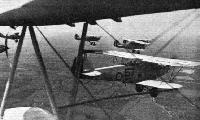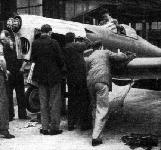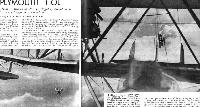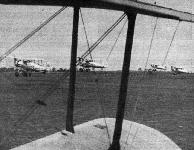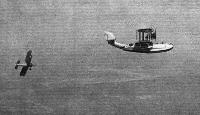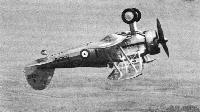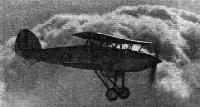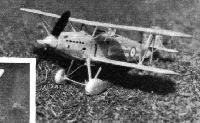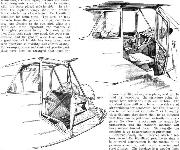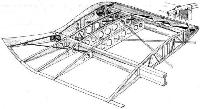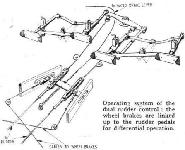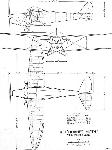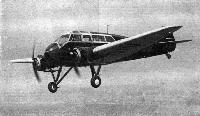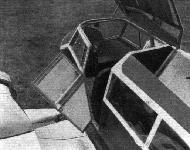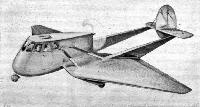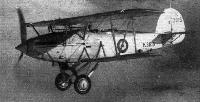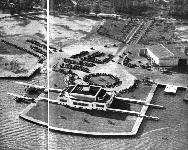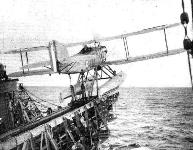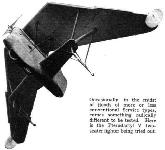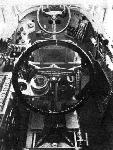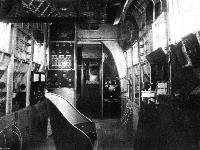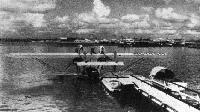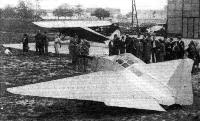Фотографии
-
The Fairey IIID (Rolls-Royce "Eagle") in which Coutinho and Cabral made the first South Atlantic crossing in 1922. Behind it is another historical machine, a Schreck flying boat acquired by the Portuguese Naval Aviation Service in 1917.
Самолёты на фотографии: Fairey Fairey III - Великобритания - 1917FBA Type A/B/C - Франция - 1913
-
Регистрационный номер: K2966, K2977, K3031 BOMBERS INTO FIGHTERS: The "Harts" (525 h.p. "Kestrel" I.B.) of No. 601 (County ot London) Fighter Squadron display their new markings - alternate triangles of scarlet and black. These were adopted when the unit undertook fighter duties; formerly, of course, it was a bomber squadron. "Demons" are soon expected.
Самолёты на фотографии: Hawker Hart - Великобритания - 1928
-
SERVICE MODES. A group of pilots caught by a Flight camera during a rehearsal at Upper Heyford last Friday for the special formation-flying item at the forthcoming Hendon Display. The squadrons concerned are Nos. 15, 18 and 57, and the machines are "Harts." Service flying kit of to-day makes an interesting contrast to the well-remembered fashions of 1916-18.
Самолёты на фотографии: Hawker Hart - Великобритания - 1928
-
Регистрационный номер: K2457 No. 57 (Bomber) Squadron at Upper Heyford, flying the "Hart," which is the fastest light bomber in the R.A.F.
Самолёты на фотографии: Hawker Hart - Великобритания - 1928
-
Регистрационный номер: K2124 Fastest of the R.A.F.'s bombing types, the Hawker "Hart" uses a 525 h.p. unsupercharged water-cooled "Kestrel."
Самолёты на фотографии: Hawker Hart - Великобритания - 1928
-
FOR THE KING'S CUP. In the maker's works at Reading this racing "Hawk Major" two-seater is nearing completion. Fitted with a boosted "Gipsy Major" giving 146 h.p., it will be flown by Mr. Cook, who competed in last year's event on a "Gipsy Swift." The new machine has a coupe top which gives it exceptionally good lines, and it should do well.
Самолёты на фотографии: Miles Hawk / M.2 - Великобритания - 1932
-
NON-STOP TO BUCHAREST is the aim of Mlle. Braescu, who is to leave Croydon in the near future in a special Miles "Hawk Major" ("Gipsy Major"). The machine, which is named Aurd Vlaicu after the first Rumanian pilot, is a single-seater with coupe top, and is equipped to carry 100 gallons of fuel, giving a range of 1,500 miles.
Самолёты на фотографии: Miles Hawk / M.2 - Великобритания - 1932
-
CABIN COMFORT: Signor Parodi, the pilot of a Miles "Falcon," is congratulated after winning the Raduno Sahariano in Tripoli. General Balbo, in a sun helmet, can be seen beside the engine cowling. The "Falcon" was the only English machine in the Rally.
Самолёты на фотографии: Miles Falcon M.3 / Hawcon M.6 - Великобритания - 1934
-
The backbone of our day-and-night fighter equipment - the well-tried Bristol "Bulldogs," which have been used by the majority of fighter squadrons during the past few years.
Самолёты на фотографии: Bristol Bulldog - Великобритания - 1927
-
No. 54 (Fighter) Squadron, flying Bristol "Bulldogs" ("Jupiter" engines), rallying after an attack on the "Southamptons" (Napier "Lion" engines) of No. 204 (Flying-Boat) Squadron. One fin and rudder of a flying boat appears to the left of the picture.
Самолёты на фотографии: Bristol Bulldog - Великобритания - 1927Supermarine Southampton / Solent - Великобритания - 1925
-
"Bulldogs" of No. 54 (Fighter) Squadron attacking a "Southampton." This photograph shows the view from the front cockpit of the flying-boat. Above the tail plane is one "Bulldog" turning to break away after attacking, while another can be seen below diving out of range.
Самолёты на фотографии: Bristol Bulldog - Великобритания - 1927Supermarine Southampton / Solent - Великобритания - 1925
-
Gloster "Gauntlets" of No. 19 (Fighter) Squadron - the latest and fastest type of fighter in service in the world. Its top speed at 15,800 feet is 230 m.p.h. These remarkable Flight photographs were taken from a two-seater "Bulldog" which flew as a member of the single-seater formation.
Самолёты на фотографии: Bristol Bulldog - Великобритания - 1927Gloster Gauntlet - Великобритания - 1929
-
A. "Southampton" attacked from the rear by a "Bulldog," as seen from another boat of No. 204 (Flying-Boat) Squadron.
Самолёты на фотографии: Bristol Bulldog - Великобритания - 1927Supermarine Southampton / Solent - Великобритания - 1925
-
HERALDRY at HENDON: "Bulldog" No. 3 (F.) Squadron
Самолёты на фотографии: Bristol Bulldog - Великобритания - 1927
-
HERALDRY at HENDON: "Bulldog" No. 17 (F.) Squadron
Самолёты на фотографии: Bristol Bulldog - Великобритания - 1927
-
A FRENCH VISIT: Four bombers of the Marcel Bloch type arrived at Northolt on Monday on a visit to the R.A.F. Gen. R. Massenet de Marancour is in command. They were met by A. V-M. Joubert de la Ferte.
Самолёты на фотографии: Bloch MB.200 - Франция - 1933
-
TRULY RURAL: A Westland "Wessex" of Cobham Air Routes coming into L'Eree aerodrome in Guernsey. An accurate approach is obviously necessary, but one doubts if the pilot is really cutting things as fine as would appear from this picture.
Самолёты на фотографии: Westland Wessex / Westland IV - Великобритания - 1929
-
Two 620 h.p. "Pegasus" radials power the 152 m.p.h. "Overstrand" medium bomber.
Самолёты на фотографии: Boulton Paul Overstrand / P.75 - Великобритания - 1933
-
Регистрационный номер: J9770 Самолёты на фотографии: Boulton Paul Overstrand / P.75 - Великобритания - 1933
-
These large, comfortable berths make it easy to sleep while flying at night in a Curtiss "Condor" on American Airlines.
Самолёты на фотографии: Curtiss Condor 18 - США - 1929
-
Регистрационный номер: K5200 The Gloster "F.7/30" four-gun single-seater fighter (Bristol "Mercury") will be seen at the S.B.A.C. Display. It is here seen in inverted flight, piloted by Mr. P. E. G. Sayer.
Самолёты на фотографии: Gloster Gladiator - Великобритания - 1934
-
The "Fury" single seater is fitted with the 525 h.p. supercharged water-cooled "Kestrel."
Самолёты на фотографии: Hawker Fury - Великобритания - 1931
-
Flying scale model from Mr. L. S. Wigdor's big fleet. A Hawker "High-speed Fury," which even has the scale number of fuselage stringers and wing ribs
Самолёты на фотографии: Hawker Fury - Великобритания - 1931
-
HERALDRY at HENDON: "Fury" No. 7 (F.) Squadron
Самолёты на фотографии: Hawker Fury - Великобритания - 1931
-
HERALDRY at HENDON: "Fury" No. 25 (F.) Squadron
Самолёты на фотографии: Hawker Fury - Великобритания - 1931
-
Mr. Brie, with the help of a fair wind, shows exactly what the C.30 can do.
Самолёты на фотографии: Cierva/Avro C.30A / Rota - Великобритания - 1932
-
Регистрационный номер: K4232, SE-AZB The "Rota" (140 h.p. "Civet I") has a number of qualities suiting it to army co-operation requirements.
Самолёты на фотографии: Cierva/Avro C.30A / Rota - Великобритания - 1932
-
Самолёты на фотографии: Cierva/Avro C.30A / Rota - Великобритания - 1932
-
Gloster Gauntlet Is from Henlow, June 1935
Gloster Gauntlets were the main equipment of 14 Fighter Command squadrons in 1937. By 1939 the type had been replaced by the Gladiator and Hurricane though on the outbreak of war some RAF Auxiliary squadrons had a number still in service. In 1936 the Gauntlet was the fastest RAF fighter in service.Самолёты на фотографии: Gloster Gauntlet - Великобритания - 1929
-
Регистрационный номер: K4094 POETRY OF ACTION: This graphic picture of the new "Mercury"-engined "Gauntlets" of No. 19 (Fighter) Squadron in a concerted dive was secured by a Flight photographer from a two-seater "Bulldog" flying as one of the formation. The air drill by this unit - in all probability the best equipped of its kind in the world - will form a high-light in a brilliant programme at Hendon next Saturday.
Самолёты на фотографии: Gloster Gauntlet - Великобритания - 1929
-
HERALDRY at HENDON: "Gauntlet" No. 19 (F.) Squadron
Самолёты на фотографии: Gloster Gauntlet - Великобритания - 1929
-
Регистрационный номер: K3698 A standard type, which equips the majority of army co-operation squadrons, is the "Kestrel"-engined "Audax".
Самолёты на фотографии: Hawker Audax - Великобритания - 1931
-
The "Cloud," another Saro product is an amphibian used for navigational training.
Самолёты на фотографии: Saunders-Roe Cloud / A.19 - Великобритания - 1930
-
The Vickers-Supermarine "Seagull V" pusher amphibian flying boat, with Bristol "Pegasus" engine.
Самолёты на фотографии: Supermarine Walrus/Seagull V - Великобритания - 1933
-
This is the first photograph taken of the new Sikorsky S.43, which, although it is an amphibian, can carry fifteen passengers and 550 lb. of mail for a distance of 1,000 miles at 165 m.p.h.
Самолёты на фотографии: Sikorsky S-43 Baby Clipper/JRS/Y1OA-8 - США - 1936
-
SIKORSKY S.43 Two PRATT AND WHITNEY S1EG GEARED "HORNETS" OF 750 H.P.
Самолёты на фотографии: Sikorsky S-43 Baby Clipper/JRS/Y1OA-8 - США - 1936
-
Регистрационный номер: K4771 24 марта 1935г.: компания "Avro" впервые подняла в воздух прототип модификации своего самолета Type 652, приспособленный для прибрежного патрулирования - Type 652A, K4771.
Прототип Anson сохранил квадратные окна кабины Type 652, на смену которым у серийных самолетов пришла характерная "оранжерея". Конструкция ветрового козырька также подверглась незначительным доработкам.
A Coastal Reconnaissance machine, the Avro 652 (Conversion) is the military version of the firm's commercial monoplane. It has two Siddeley "Cheetah VI" engines of 290 h.p. each.Самолёты на фотографии: Avro Anson / Type 652 - Великобритания - 1935
-
The Bristol Troop Carrier, unlike most modern machines, is a high-wing monoplane. The engines are Bristol "Pegasus" of 700 h.p. each.
Самолёты на фотографии: Bristol Bombay / Type 130 - Великобритания - 1935
-
A view showing twelve of the fourteen passengers inside a standard Douglas D.C.2. as used by the majority of America's air transport companies.
Самолёты на фотографии: Douglas DC-1 / DC-2 / C-32 / C-39 - США - 1933
-
Регистрационный номер: F-ANPG ON THE MARSEILLES SERVICE: One of the new Potez 62 monoplanes which are being used on Air France's Paris-Lyons-Marseilles run, reducing the time for the journey by half an hour. The machine carries fourteen passengers and a steward.
Самолёты на фотографии: Potez Potez 62 / 65 - Франция - 1935
-
A fast fighter. The Fairey "Fantome" (860 h.p. Ycrs Hispano-Suiza engine) built for a single-seater fighter competition being held by the Belgian government. No performance figures are available, but one stipulation of the competition is that machines must be capable of at least 250 m.p.h. The armament includes four machine guns and the "cannon" which fires through the airscrew shaft.
Самолёты на фотографии: Fairey Fantome / Feroce - Бельгия - 1935
-
Регистрационный номер: OO-TIP The Tipsy "S" is an extremely pretty little aeroplane.
Самолёты на фотографии: Tipsy S - Бельгия - 1935
-
Регистрационный номер: K3363, K3364, K3365 A TUTORIAL TRICK. Instructors from The Central Flying School, Wittering, in special "Tutors," rehearse a phase of their inverted flying act to be given at Hendon on June 20. The rearmost machines, of course, are not in their normal attitude...
Самолёты на фотографии: Avro Tutor/Sea Tutor/Prefect / Type 621/646/626 - Великобритания - 1929
-
Регистрационный номер: K5063 SCHOLASTIC. This special version of the Avro "Tutor" (215 h.p. "Lynx") built for Royal Air Force use, and known officially as the "Prefect," is to be used initially for navigational training; a number are on order. Increased tankage appears to be a feature.
Самолёты на фотографии: Avro Tutor/Sea Tutor/Prefect / Type 621/646/626 - Великобритания - 1929
-
F/O. G. King's machine snapped during the hectic display which he gave in company with F/O. V. Moon; both flew "Tiger Moths."
Самолёты на фотографии: De Havilland Tiger Moth / D.H.82 - Великобритания - 1931
-
Flt. Lt. Johnson makes a final circuit - dead on time - around the Hatfield beacon after his aerobatic display with the "Tiger Moth."
Самолёты на фотографии: De Havilland Tiger Moth / D.H.82 - Великобритания - 1931
-
Регистрационный номер: G-ADEA HILLMAN'S BIGGEST: The first of the three D.H. 86 machines ordered by Hillman's Airways for their Paris service taken by a Flight photographer while it was flying above the clouds near Hatfield. This machine is fitted with full dual control though the later 86 's will have the swing-over type.
Самолёты на фотографии: De Havilland Express Air Liner / D.H.86 - Великобритания - 1934
-
Lady Cunliffe-Lister christens Hillman's first D.H.86. Capt. T. N. Stack can be seen, with the chief pilot, Capt. Anderson, beside him, standing beneath the nose.
Самолёты на фотографии: De Havilland Express Air Liner / D.H.86 - Великобритания - 1934
-
Регистрационный номер: G-ADIS A NEW DE HAVILLAND MACHINE: The "Hornet Moth" (130 h.p. "Gipsy Major") is a side-by-side two-seater. It will be seen for the first time at the S.B.A.C. Display.
Самолёты на фотографии: De Havilland Hornet Moth / D.H.87 - Великобритания - 1934
-
The forward part of the fuselage structure. The box on which the seats rest can be used for carrying tools, batteries, etc. The finished cabin is shown in the upper sketch. The right-hand control handle is detachable.
Самолёты на фотографии: De Havilland Hornet Moth / D.H.87 - Великобритания - 1934
-
The wing construction of the "Hornet Moth" is of wood. The root of the lower starboard wing is shown, with trailing edge raised to meet the corner of the fuselage.
Самолёты на фотографии: De Havilland Hornet Moth / D.H.87 - Великобритания - 1934
-
Operating system of the dual rudder control: the wheel brakes are linked up to the rudder pedals for differential operation.
Самолёты на фотографии: De Havilland Hornet Moth / D.H.87 - Великобритания - 1934
-
The tail surfaces are of normal De Havilland form, but trimming "tabs" are fitted on the elevators and the tailplane is fixed. The right-hand sketch shows the tailplane structure.
Самолёты на фотографии: De Havilland Hornet Moth / D.H.87 - Великобритания - 1934
-
D.H. "Hornet Moth" Gipsy Major Engine
Самолёты на фотографии: De Havilland Hornet Moth / D.H.87 - Великобритания - 1934
-
The new Monospar S.T.25.
Самолёты на фотографии: General Aircraft Monospar ST-25 Universal - Великобритания - 1935
-
The cabin door arrangement; the new curved screen is also visible.
Самолёты на фотографии: General Aircraft Monospar ST-25 Universal - Великобритания - 1935
-
Регистрационный номер: K2850 [2] Two-seater fighters were much used during the war and were re-introduced into the R.A.F. a few years ago. The "Demon" is the standard type, and the picture shows a flight of "Demons" of No. 23 (Fighter) Squadron, which is stationed at Biggin Hill.
Самолёты на фотографии: Hawker Demon - Великобритания - 1932
-
Регистрационный номер: K2850 [2] The "Demon" two-seater is fitted with the 525 h.p. supercharged water-cooled "Kestrel."
Самолёты на фотографии: Hawker Demon - Великобритания - 1932
-
HERALDRY at HENDON: "Demon" No. 23 (F.) Squadron
Самолёты на фотографии: Hawker Demon - Великобритания - 1932
-
Capt. Percival leaving Gravesend at 1.30 a.m. He reached Oran at 8.40 a.m., left at 11 a.m., and reached Croydon at 6.20 p.m.
Самолёты на фотографии: Percival Gull - Великобритания - 1932
-
CLAIMING THEIR RIGHTS: An amusing incident at the recent rally of model aero clubs at Sywell Aerodrome. Several petrol-driven models appeared, and the realistic Percival "Gull" in the foreground made the best performance in this section.
Самолёты на фотографии: Percival Gull - Великобритания - 1932
-
Регистрационный номер: D-EMYV, D-EPAT, D-EPEM, D-EPET, D-ERIL A LOW-WING CONVENTION. This striking photograph, taken at Tempelhof, shows some of the 154 machines which took part in the recent Deutschlandflug (Circuit of Germany). In the foreground are a number of Klemms, a squadron of which, as reported last week, carried off the principal award.
Самолёты на фотографии: Klemm L.25 - L.28 Swallow - Германия - 1927
-
The S.42 at Miami. The rails on which this platform is raised can be seen; a few moments later the platform was level with the quay and the S.42 was pulled off into the hangar by a small motor tractor.
Самолёты на фотографии: Sikorsky S-42 Clipper - США - 1934
-
The Brazilian Clipper (Sikorsky S.42) off Honolulu during a trans-Pacific flight.
Самолёты на фотографии: Sikorsky S-42 Clipper - США - 1934
-
TOWARDS THE IDEAL: In Flight of December 6, last year, a new type of pusher for private owner use was described. This machine the Hammond Model Y, was designed to the order of the U.S. Bureau of Air Commerce, and its various novel features can be gathered from this sketch.
Самолёты на фотографии: Stearman-Hammond Y-1 - США - 1936
-
Регистрационный номер: D-EQAN BALLOONACY: Flying a Messerschmitt monoplane, Herr Stor, the German stunt pilot, entertained the Deutschlandflug spectators by a display of low-altitude inverted flying. A balloon-bursting competition might have enhanced the effect.
Самолёты на фотографии: Messerschmitt BFW M.35 - Германия - 1933
-
Регистрационный номер: K3615 A two-seater, the "Osprey" uses a moderately-supercharged "Kestrel" of 525 h.p.
HAWKER OSPREY IV: Fleet fighter reconnaissance (Kestrel V engine - 640 h.p. at 14,000ft.); span, 37ft.; gross weight, 4,970 lb.; max. speed, 173 m.p.h. at 16,400ft.Самолёты на фотографии: Hawker Osprey - Великобритания - 1930
-
Formations of No. 504's "Wallaces" flying over their home city of Nottingham.
Самолёты на фотографии: Westland Wallace / PV.3 / PV.6 - Великобритания - 1931
-
Photograph taken at Hucknall shows armourers loading-up with practice bombs for use on the range at Waddington
Самолёты на фотографии: Westland Wallace / PV.3 / PV.6 - Великобритания - 1931
-
Photograph taken at Hucknall shows aircraftmen at work on one of the Wallaces
Самолёты на фотографии: Westland Wallace / PV.3 / PV.6 - Великобритания - 1931
-
Самолёты на фотографии: Westland Wallace / PV.3 / PV.6 - Великобритания - 1931
-
The Westland "Wallace" is fitted with the 555 h.p. Bristol "Pegasus IM3" respectively.
Самолёты на фотографии: Westland Wallace / PV.3 / PV.6 - Великобритания - 1931
-
Регистрационный номер: G-ACSS, K5084 This photograph of the D.H.88 Comet G-ACSS was taken at the time of its Air Ministry trials during 1935-36. The perfect racing lines are particularly evident in this picture.
Самолёты на фотографии: De Havilland Comet / D.H.88 - Великобритания - 1934
-
IN THE FLOODLIGHTS: This photograph, taken by a Flight photographer at Heston during the Household Brigade display, gives some idea of the value of modern floodlighting equipment. Those at Heston, of course, are of Chance manufacture, and the machine is an Airspeed "Envoy"
Самолёты на фотографии: Airspeed Envoy / AS.6 - Великобритания - 1934
-
In the main hall: Over the aisle is the D.H. "Leopard Moth" in which Lt. Humberto da Cruz and Sgt. Mech. Lobato flew from Lisbon to Portuguese Timor, and suspended from the roof is the Portuguese "Varela Sid" flying-boat glider.
Самолёты на фотографии: De Havilland Leopard Moth / D.H.85 - Великобритания - 1933Varela Cid Portugal - Португалия - 1934
-
The faithful "Virginia" is a heavy bomber with two water-cooled "Lions.'' The type is being replaced.
Самолёты на фотографии: Vickers Virginia - Великобритания - 1922
-
Pan-America's idea of what a flying boat terminal should be. Here, at Dinner Key, Miami, four flying boats can be loaded simultaneously. A Sikorsky S.40 and a Consolidated "Commodore" are alongside the piers on the left. On the right can be seen the beaching platform which runs down on rails into the water and, when drawn up, lifts out the flying boat.
Самолёты на фотографии: Consolidated Commodore / PY Admiral - США - 1929Sikorsky S-40 - США - 1931
-
Flying scale model from Mr. L. S. Wigdor's big fleet. A Curtiss F.9.C.2 Macon fighter (the type carried by the ill-fated U.S. airship) of 19 1/8 in. span and weighing 2.2 oz.
Самолёты на фотографии: Curtiss F9C Sparrowhawk - США - 1931
-
An aerial view of the landing stage and aerodrome at San Juan, Porto Rico. An S.40 is alongside the stage.
Самолёты на фотографии: Sikorsky S-40 - США - 1931
-
The Hawker "Nimrod" is a single-seater fleet fighter with the fully supercharged 525 h.p. "Kestrel IIS."
Самолёты на фотографии: Hawker Nimrod - Великобритания - 1931
-
The Plummer: A "Nimrod" fleet fighter enters a terminal velocity dive in which it will reach a speed in the region of 400 m.p.h.
Самолёты на фотографии: Hawker Nimrod - Великобритания - 1931
-
Регистрационный номер: S1781 The aircraft is just leaving the trolley, which, it can be seen, has reached the extended forward portion of the catapult, at which point it is decelerated by the liquid-controlled recoil ram.
Самолёты на фотографии: Fairey Fairey IIIF - Великобритания - 1926
-
YOUNG ENTHUSIASTS, members of the Skybird League, who recently visited the new aerodrome at Southend-on-Sea as guests tf the Southend Flying Club. They are seen standing by the Club's Short "Scion," in which Mr. A. M. Glover (Chief Instructor) gave many of them flights.
Самолёты на фотографии: Short Scion / S.16 - Великобритания - 1933
-
Регистрационный номер: K3585 [2] A new Bomber Transport: The Armstrong Whitworth A.W.23, which has two 800 h.p. Siddeley "Tiger VI" engines.
Самолёты на фотографии: Armstrong Whitworth A.W.23 - Великобритания - 1935
-
Регистрационный номер: K3585 [2] THE LATEST: It is now permissible to publish a photograph of the new Armstrong-Whitworth Bomber Transport - a low-wing cantilever monoplane with retractable undercarriages. The engines are Siddeley "Tigers."
Самолёты на фотографии: Armstrong Whitworth A.W.23 - Великобритания - 1935
-
Регистрационный номер: G-ABXL Side and head-on views of the "Archaeopteryx" - an unconventional semi-tailless machine which first appeared in 1930 - in which Sir Philip Cunliffe-Lister and Lord Trenchard showed great interest.
Самолёты на фотографии: Granger Archaeopteryx - Великобритания - 1930
-
Mr. E. D. Ayre sets off, pipe in mouth, to give a demonstration of the impossible - with the B.A.C. "Drone."
Самолёты на фотографии: Kronfeld Drone - Великобритания - 1932
-
Occasionally, in the midst of floods of more or less conventional Service types, comes something radically different to be tested. Here is the Pterodactyl V two-seater fighter being tried out.
Самолёты на фотографии: Westland-Hill Pterodactyl V - Великобритания - 1934
-
1931 was the year in which it seemed the estimable Capt. Hill's efforts were to be rewarded, when his two-seat Pterodactyl Mk.V proposals gained Air Ministry acceptance, with the one proviso that the machine be powered by a 600hp Rolls-Royce PV.G, later known as the Goshawk. With the relevant paperwork completed, work on the sole Mk. V, K 2770, commenced in early 1932, against Air Ministry Specification F.3132. Completed in the autumn of 1932, K 2770 started taxiing trials, only to have the left wing collapse. The cause of this was traced back to a design stressing error, which had been unearthed by a bump on the grass airfield. Thus, another sixteen months were to pass before the machine actually took to the air for the first time, in May 1934. Dogged by the now traditional pitch control sensitivity problems, an unreliable engine and a top speed of 165mph at 15.000 feet, nearly 20mph slower than that of the RAF's then standard Hawker Hart day bomber, it is little wonder that the whole project was quietly abandoned.
Самолёты на фотографии: Westland-Hill Pterodactyl V - Великобритания - 1934
-
Регистрационный номер: S1589 [6] The mighty "Sarafand" or R.6/28 (six 825 h.p. "Buzzards")
Самолёты на фотографии: Short Sarafand / S.14 - Великобритания - 1932
-
One of the jacks used for lifting the flying boat off the ground when it is ashore. The ends of the beam are placed under points on the lower wing roots.
Самолёты на фотографии: Short Sarafand / S.14 - Великобритания - 1932
-
Регистрационный номер: S1589 [6] Although dual controls are provided, the pilots are arranged in tandem to give the first pilot the best possible view.
Самолёты на фотографии: Short Sarafand / S.14 - Великобритания - 1932
-
Регистрационный номер: S1589 [6] A view looking forward. The compartment in the foreground has a workbench with vice, etc., and a hatch through which can be lowered a spare engine.
Самолёты на фотографии: Short Sarafand / S.14 - Великобритания - 1932
-
Регистрационный номер: S1589 [6] The exchange: In this compartment are the switchboard for the electricity supply, telephones, etc., and the engine instruments under the care of the engineer.
Самолёты на фотографии: Short Sarafand / S.14 - Великобритания - 1932
-
Регистрационный номер: S1589 [6] The aft stowage space, and lavatory equipment. A gangway leads to the gun position in the extreme stern of the hull.
Самолёты на фотографии: Short Sarafand / S.14 - Великобритания - 1932
-
Регистрационный номер: S1589 [6] The picture affords a peep into the W/T compartment.
Самолёты на фотографии: Short Sarafand / S.14 - Великобритания - 1932
-
Регистрационный номер: NC146M A Sikorsky S.38 alongside a typical landing stage, at San Juan, Porto Rico. The tanks for both engines are being refuelled simultaneously.
Самолёты на фотографии: Sikorsky S-36 / S-38 - США - 1927
-
ON SILENT WINGS: A striking picture of the "Golden Wren" sailplane and a Rhon "Buzzard" soaring over Bradwell Edge, Derbyshire, which is proving an increasingly popular centre with Midland and Northern gliding enthusiasts.
Самолёты на фотографии: Manuel Wren - Великобритания - 1931Schleicher Rhonbussard - Германия - 1933
-
Among the seven flying boats which are to appear at the R.A.F. Display on Saturday is the Vickers-Supermarine "Scapa," which is now being used in considerable numbers; its duties include reconnaissance, bombing, and navigational training. The engines are two Rolls-Royce "Kestrel III M.S." (525 h.p. moderately supercharged vee-twelve water-cooled); the span is 75 ft. and overall length 53 ft. This part-sectional drawing by G. H. Davis shows the layout of the crew accommodation and principal features.
Самолёты на фотографии: Supermarine Scapa - Великобритания - 1932
-
An Armstrong Whitworth general-purpose biplane shows her mettle during handling tests.
Самолёты на фотографии: Armstrong Whitworth A.W.19 - Великобритания - 1934
-
Регистрационный номер: K2773 The Handley Page H.P.47 General Purpose monoplane (700 h.p. Bristol "Pegasus" engine).
Самолёты на фотографии: Handley Page H.P.47 - Великобритания - 1933
-
The Hawker "P.V.4" General Purpose and Dive Bomber aeroplane. The engine is a 700 h.p. Bristol "Pegasus."
Самолёты на фотографии: Hawker PV.4 - Великобритания - 1934
-
THE BOMB-THROWER: It is now possible to disclose the nature of this new "Pegasus"-engined Hawker machine, which was first illustrated in Flight last February. Although a general-purpose type, it has been specially designed for dive bombing, and for this work is claimed to be superior to any foreign design. Its designation is P.V.4, the letters, of course, signifying "private venture," i.e., not built to any particular Air Ministry specification.
Самолёты на фотографии: Hawker PV.4 - Великобритания - 1934
-
SANS QUEUE. The latest French contribution to the "flying flatfish" cult, M. Fauvel's machine has a 75 h.p. Pobjoy engine, giving a top speed of 115 m.p.h.
Самолёты на фотографии: Fauvel AV.10 - Франция - 1935
-
TAILS UP! This weird machine, built in France by the Vicomte Charles de Rouge, is claimed to have helicopter-like qualities. The tail surfaces appear to be hinged and to give longitudinal control.
Самолёты на фотографии: De Rouge Elytroplan - Франция - 1935
-
Регистрационный номер: K2771 Although seated in a commanding position, the pilot of the Vickers General Purpose biplane (700 h.p. Bristol "Pegasus") is well protected from the elements.
Самолёты на фотографии: Vickers G.4/31 / Type 253 - Великобритания - 1934
-
The new Hawker "P.V.3" is a four-gun single-seater fighter with Rolls-Royce "Goshawk" engine. Its performance is said to be "Schneiderish."
Самолёты на фотографии: Hawker PV.3 - Великобритания - 1934
Статьи
- Flight
- Flight Advertisements



